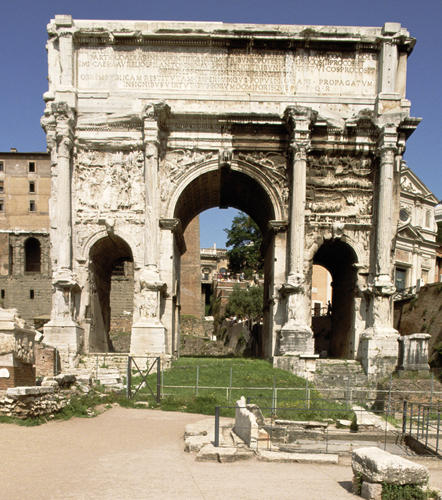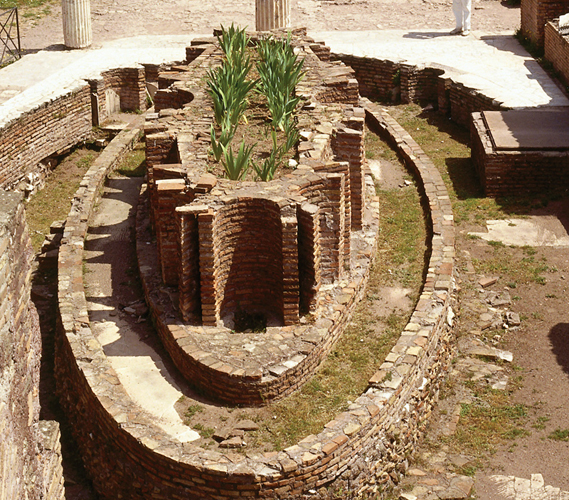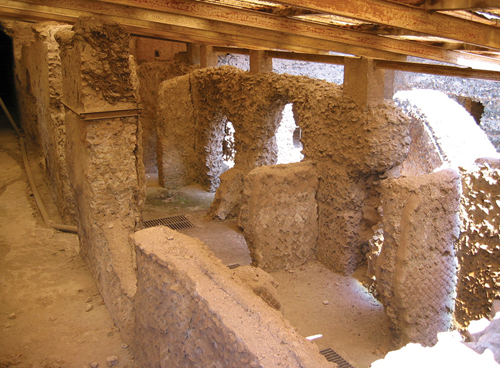Roman Forum
Gazing on it today, a picturesque shambles of ruins and weeds, you would hardly guess that the Forum was the symbol of civic pride for 1,000 years. Its humble beginning, more than 3,000 years ago, was as a swampy cemetery for the original village on Palatine Hill. Gradually it rose, ever more glorified, as Rome’s power grew. After the marsh was finally drained off in the 6th century BC, it took on its central role in the life of the Republic. The Forum showed its most elegant face starting with the reign of Augustus, the first Roman emperor, who is said to have turned the city from brick to marble.
|
You can access the Forum from Via Dei Fori Imperiali. However, for a great view of the whole site, enter from one of the high points at either end. From the north-west end, begin on the Capitoline (to the right and behind the huge, white Victor Emmanuel Monument) and take the stairs down from Largo Romolo e Remo. From the southeast end, start at the Colosseum and climb the small hill just to the northwest. Enter by the Arch of Titus, which is also near the main entry gate to the Palatine.
|

Original Plan of the Roman Forum
 |
The only option in the immediate area for drinks and snacks is one of the mobile refreshment vendors. For something more substantial, there are plenty of cafés and restaurants on Via Cavour.
|
|
 |
In summer, it’s best to visit the Forum either early or late in the day, to avoid the intense heat.
|
|
Top 10 Features
Arch of Septimius Severus
This well-preserved triumphal arch celebrates the emperor’s Middle Eastern victories. It was erected in AD 203 by his sons, Geta and Caracalla, then co-emperors.

Temple of Vesta and House of the Vestal Virgins
A graceful round temple and its adjacent palace were the centre for one of Rome’s most revered cults. Noble priestesses tended the sacred flame and enjoyed the greatest privileges.

Curia
The 3rd-century-AD Senate retains its original polychrome inlaid floor, its risers, where the 300 senators sat in deliberation, and the speaker’s platform. For 2nd-century views of the Forum, examine the large marble reliefs, showing Emperor Trajan’s good works.

The Curia
Temple of Castor and Pollux
Three Corinthian columns remain of this temple to the Dioscuri – twin brothers of Helen of Troy and sons of Jupiter and Leda. The shrine marked the spot where they miraculously appeared in 499 BC to announce a crucial Roman victory.

Arch of Titus
The oldest extant arch in Rome was erected in AD 81 by Emperor Domitian to honour his brother, Titus, and his father, Vespasian, for putting down the Jewish Revolt. Reliefs show soldiers sacking Jerusalem’s Holy of Holies and taking sacred objects, such as a golden menorah.

Basilica of Maxentius and Constantine
Three vast, coffered barrel vaults proclaim the Forum’s largest structure, built around AD 315 and used as the legal and financial centre of the Empire.

Temple of Vespasian
Until 18th-century excavations were undertaken, these graceful corner columns (AD 79) of the temple to a former emperor stood mostly buried beneath centuries of detritus.
Via Sacra
Paved with broad, flat, black basalt stones, Rome’s oldest road wound from the Arch of Titus through the Forum and up to the Capitoline. Republican heroes staged triumphal processions here, but it degenerated into a hang-out for gossips, pick-pockets and other idlers.

Temple of Saturn
Eight grey-and-red Ionic columns constitute what’s left of this temple (also the state treasury) to the ruler of agriculture and of a mythic “Golden Age.” Saturnalia, celebrated each December, was very similar to modern-day Christmas.

Temple of Antoninus and Faustina
Dedicated by Antoninus Pius in AD 41 to his deified wife Faustina, this is one of the best preserved temples. With its Baroque-style top-knot, it is also one of the oddest. Note the carvings of griffins along the side frieze.

Palatine Hill Features

Plan of Palatine Hill
Domus Flavia
Marked today mainly by the remains of two fountains, this imposing edifice was the official wing of a vast emperors’ palace, built by Domitian in AD 81.

Domus Flavia
Livia’s House
This 1st-century BC structure, now below ground level, formed part of the residence of Augustus and his second wife. Here you can examine a number of mosaic pavements and wall frescoes.

Palatine Museum and Antiquarium
This former convent houses a wealth of artifacts unearthed here, including pottery, statuary, ancient graffiti and very fine mosaics. You can also study a model of the Iron Age Palatine.
Romulus’s Iron-Age Huts
Traces of the three 9th-century BC huts were uncovered in the 1940s. Legend says that this tiny village was founded by Romulus, who gave Rome its name (see Romulus and Remus).
Stadium
Possibly a racetrack, or just a large garden, this sunken rectangle formed part of Domitian’s palatial 1st-century abode.
Domus Augustana
All that remains of the private wing of Domitian’s imperial extravaganza are the massive substructure vaults.

Temple of Cybele
The orgiastic Cult of the Great Mother was the first of the Oriental religions to come to Rome, in 191 BC. Still here is a decapitated statue of the goddess. Priests worshipping Cybele ritually castrated themselves.

Farnese Gardens
Plants and elegant pavilions grace part of what was once an extensive pleasure-garden, designed by Vignola and built in the 16th century over the ruins of Tiberius’s palace.

Farnese Gardens
Cryptoporticus
This series of underground corridors, their vaults decorated with delicate stucco reliefs, stretches 130 m (425 ft). It connected the Palatine to Nero’s fabulous Golden House.
Domus Septimius Severus
Huge arches and broken walls are all that remain of this emperor’s 2nd-century AD extension to the Domus Augustana.
A Day in the Life of a Roman Household
Most Romans lived in insulae, apartment buildings of perhaps six floors, with the poorest residents occupying the cheaper upper floors. An average Roman male citizen arose before dawn, arranged his toga, and breakfasted on a glass of water. Then out into the alleys, reverberating with noise. First, a stop at a public latrine, where he chatted with neighbours. Next a visit to his honoured patron, who paid him his daily stipend. Lunch might be a piece of bread washed down with wine. Bathing waited until late afternoon, when he met his friends at a public bathhouse. There he lingered – conversing, exercising, reading, or admiring the artwork – until dinnertime. The main meal of the day was taken lying on couches, with his slaves in attendance. Then it was bedtime. Roman matrons, apart from their time at the baths, spent the entire day at home, running the household.

Roman toga
Roman Bathhouses
As the centre of Roman social life, bathhouses were grandiose affairs, as seen in the remains in the Baths of Caracalla.

Top 10 Ancient Roman Belief Systems
State Religion of Graeco-Roman Gods (especially the Capitol Triad: Jupiter, Juno, Minerva)
Household Gods: Ancestors and Genii
Cult of Cybele, the Great Mother
Deification of Emperors, Empresses and Favourites
Orgiastic Fertility Cults



















